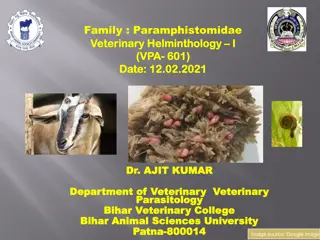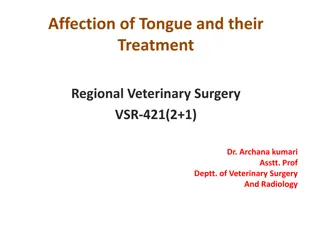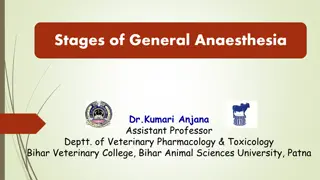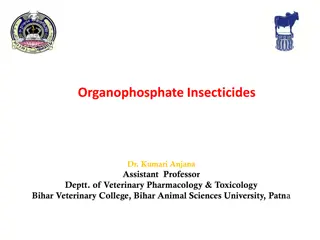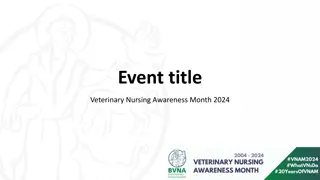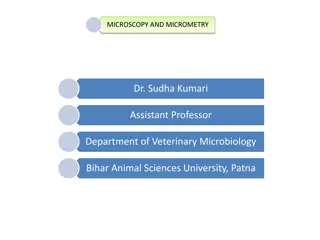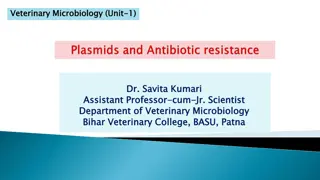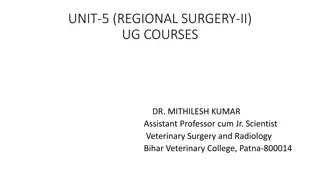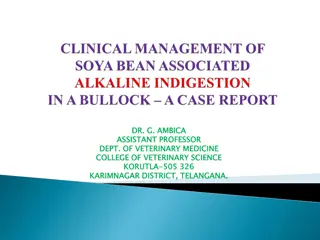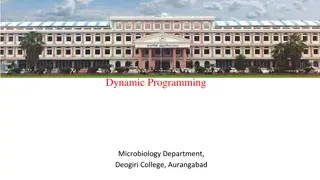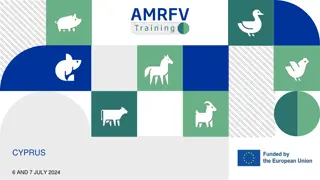Dr. Dr. Savita Savita Kumari Kumari Department of Veterinary Microbiology Bihar Veterinary College, BASU, Patna Department of Veterinary Microbiology Bihar Veterinary College, BASU, Patna
Poxviruses are a diverse family of viruses known for their complex structure and large genome. They infect a wide range of hosts, causing various diseases. Learn about different genera of poxviruses, their unique characteristics, and impact on both animals and humans.
Download Presentation

Please find below an Image/Link to download the presentation.
The content on the website is provided AS IS for your information and personal use only. It may not be sold, licensed, or shared on other websites without obtaining consent from the author.If you encounter any issues during the download, it is possible that the publisher has removed the file from their server.
You are allowed to download the files provided on this website for personal or commercial use, subject to the condition that they are used lawfully. All files are the property of their respective owners.
The content on the website is provided AS IS for your information and personal use only. It may not be sold, licensed, or shared on other websites without obtaining consent from the author.
E N D
Presentation Transcript
Dr. Dr. Savita Savita Kumari Kumari Department of Veterinary Microbiology Bihar Veterinary College, BASU, Patna Department of Veterinary Microbiology Bihar Veterinary College, BASU, Patna
Term Pox derives from English pocks, blister like skin lesions Smallpox vaccine, introduced by Edward Jenner in 1796- first successful vaccine developed Edward showed that cow pox could be used to vaccinate against smallpox Myxoma virus- first viral pathogen of laboratory animal to be described.
Two subfamilies: Chordopoxvirinae (poxviruses of vertebrates) Entomopoxvirinae (poxviruses of insects) Chordopoxvirinae - 10 genera include viruses causing disease in domestic or lab animals Entomopoxvirinae - 03 genera
Genus Orthopoxvirus Genus Virus Variola (smallpox) virus, Vaccinia virus Cowpox virus, Buffalopox virus, Camelpox virus Monkeypox virus, Ectromelia virus Orf virus, Pseudocowpox virus Bovine papular stomatitis virus Goatpox virus, Sheeppox virus Lumpy skin disease virus Fowlpox virus, Pigeonpox virus, Turkeypox virus Swinepox virus Virus Parapoxvirus Capripoxvirus Avipoxvirus Suipoxvirus Leporipoxvirus Molluscipoxvirus Yatapoxvirus Crocodylidpoxvirus Cervidpoxvirus Myxoma virus Molluscum contagiosum virus Yabapox virus and tanapox virus Crocodilepox virus Deerpox virus
Most complex and largest DNA viruses, Enveloped Genome-linear, double-stranded DNA Most poxvirus virions are large, pleomorphic, typically brick-shaped (22-450 nmx140-260 nm) Have irregular surface of projecting tubular or globular structures Virions of genus Parapoxvirus: Ovoid or cocoon shaped covered with long thread-like surface tubules, arranged in crisscross fashion, resembling a ball of yarn.
Lateral body Surface tubules Envelope Surface membrane Lateral body Envelope Surface membrane Nucleoprotein Nucleoprotein Core membrane Core membrane genus: Parapoxvirus genus: Orthopoxvirus
Virion consist of a dumbbell shaped core and two lateral bodies Core contains genomic DNA and viral proteins Poxviruses encode all enzymes required for transcription and replication Poxvirus infected cells produce two types of progeny virions- mature virions (MVs) and enveloped virions (EVs) Both enveloped and non-enveloped forms of the virus are infectious
occurs in the cytoplasm of host cells After fusion of the virion with the plasma membrane or after endocytosis, the viral core is released into the cytoplasm Replication and assembly occur in discrete sites within the cytoplasm (called viroplasm or viral factories) virions released by budding (enveloped virions) or by exocytosis or cell lysis (nonenveloped virions)
Enveloped virions- taken up by cells more readily and appear more important in spread of virions Virus envelopes- derived from host cell membranes contain host cell lipids Have virus-encoded proteins such as the haemagglutinin protein
Poxviruses able to survive for many months in dried scabs Virions are stable at room temperature under dry conditions sensitive to heat, detergents, formaldehyde and oxidizing agents The genera differ in ether sensitivity, Avipoxviruses are ether resistant Most poxviruses grow in embryonated hen s egg by CAM route and produces pock lesions on the CAM Infections with poxviruses, usually result in vesicular skin lesions
Transmission of poxviruses can occur: By aerosols By direct contact Mechanical transmission through arthropods Through fomites Skin lesions- principal feature of infections Pox lesions begin as macules and progress through papules, vesicles and pustules to scabs which detach leaving a scar
Sheeppox virus, goatpox virus and lumpy skin disease virus cause significant economic losses:- due to reduced milk production increased abortion rates decreased wt. gain increased susceptibility to secondary bacterial infections high mortality
infection with any one of these viruses induces cross-protection to heterologous capripoxviruses lumpy skin disease virus infects only cattle Some strains of sheeppox and goatpox viruses may infect both sheep and goats Sheep and goats of all ages affected Disease immunologically naive animals more severe in young and/or
Causing high mortality in young animals and significant economic loss Virus particles are shed from skin lesions, in ocular and nasal discharges during acute stages of disease Infection occurs through skin abrasions or by aerosol Biting insects transmit the virus mechanically
Virus replicates locally either in the skin or in the lungs Spread to regional lymph nodes is followed by viraemia and replication in various internal organs Skin lesions appear about seven days post infection Lung consolidation and haemorrhage lesions often present as areas of
incubation period of about one week Fever, oedema of eyelids, conjunctivitis and nasal discharge Affected animal may lose their appetite and stand with an arched back 1-2 days later, papules (skin nodules) up to 1 cm in dia. develop randomly on skin and in subcutis Mortality capripoxvirus may be up to 50% even in indigenous breeds. rates from some strains of
most obvious lesions in areas of skin having less wool (head, neck, ears, axillae and under the tail) lesions persist for 3-4 weeks, healing to depressed scar usually scab permanent and leave a Lesions affect the tongue and gums, and ulcerate within the mouth Mouth source of virus for infection of other animals lesions-important
often made solely on clinical grounds Intracytoplasmic inclusions in epidermal cells, Electron microscopy- poxvirus particles in material from lesions Virus isolation in lamb testis or kidney cell monolayers ELISA for capripoxvirus antigen Virus fluorescent antibody test, PCR neutralization, Western blot analysis, indirect In endemic areas, control is based on annual vaccination
caused by lumpy skin disease virus (Neethling virus), a capripoxvirus Transmission transfer through biting insects is mainly by mechanical Disease outbreaks usually occur during rainy season when insect activity is high
Virus rapidly disseminates through a leukocyte- associated viraemia Many cell types including keratinocytes, myocytes, fibrocytes and endothelial cells become infected Damage to endothelial cells results in vasculitis, thrombosis, infarction, oedema and inflammatory cell infiltration Nodular skin lesions occur
Incubation period is up to 14 days persistent fever, lacrimation, nasal discharge and a drop in milk yield Superficial lymph nodes enlarged, oedema of limbs and dependent tissues Circumscribed skin nodules particularly on the head, neck, udder and perineum Nodules also on mucous membranes of the mouth and nares Secondary bacterial infection or myiasis can exacerbate the condition Recovery may take several months Affected animals are often debilitated and pregnant cows may abort
Generalized skin nodules in cattle in an endemic area are highly suggestive of lumpy skin disease Histologically demonstration of Intracytoplasmic inclusions in recently developed lesions Capripoxvirus particles in biopsy material or desiccated crusts by electron microscopy Virus isolation in lamb testis cell rnonolayers ELISA, virus neutralization, Western blot analysis, indirect fluorescent antibody test In endemic regions- vaccination





